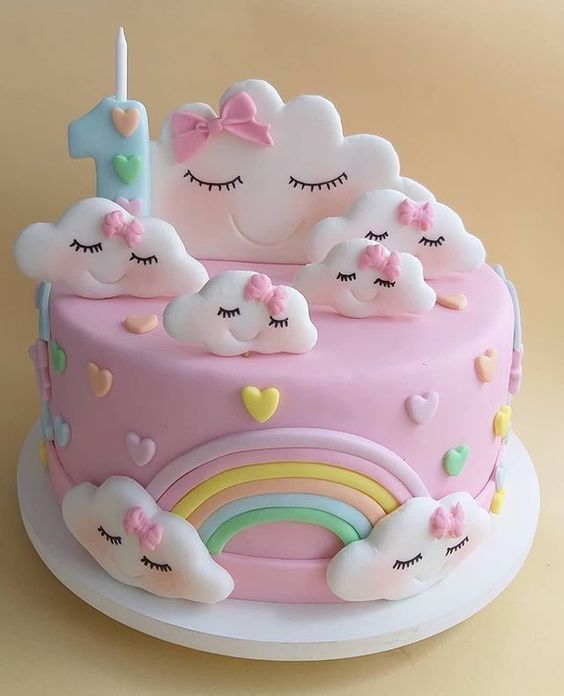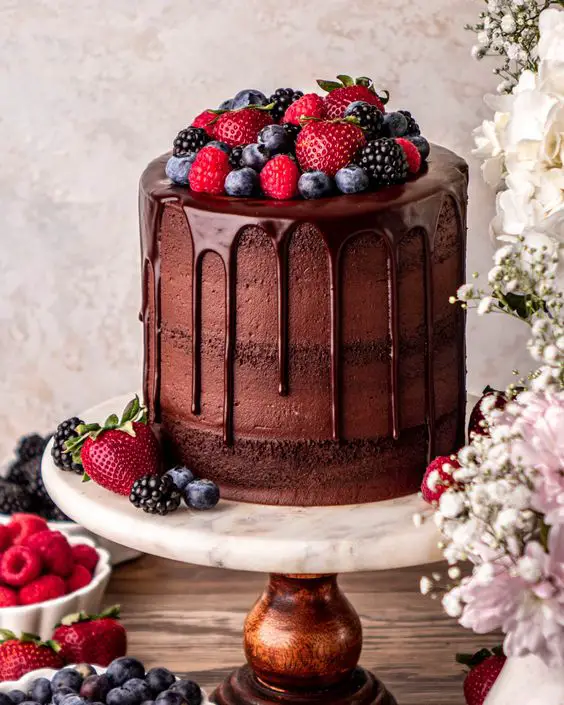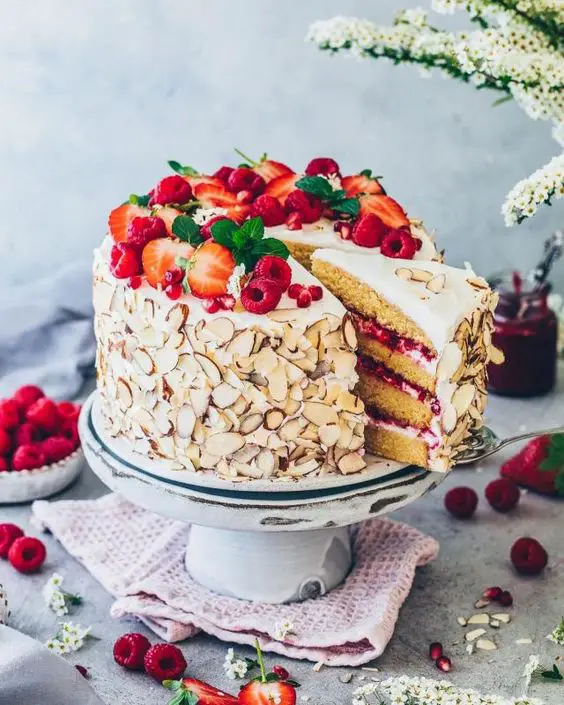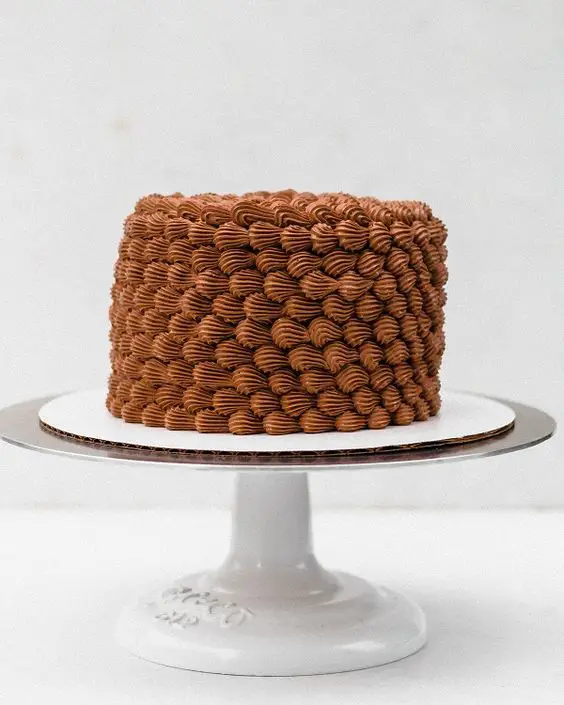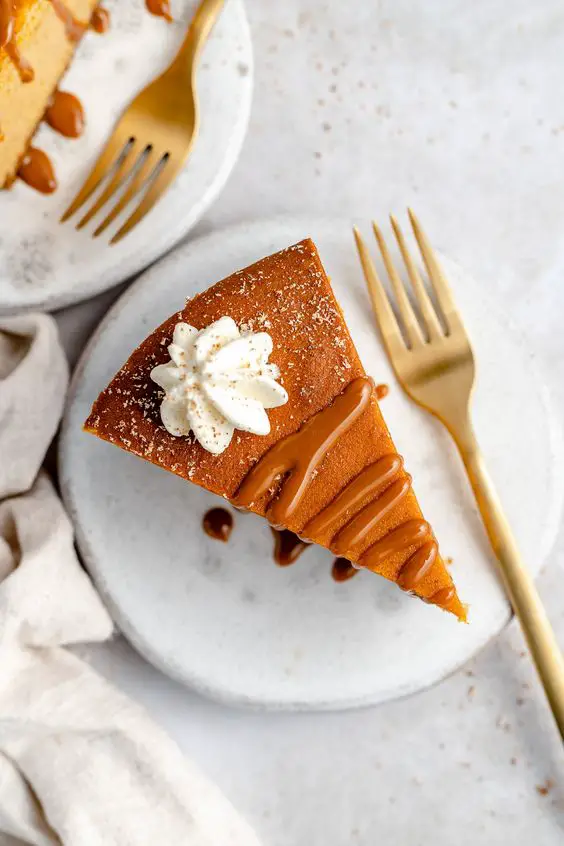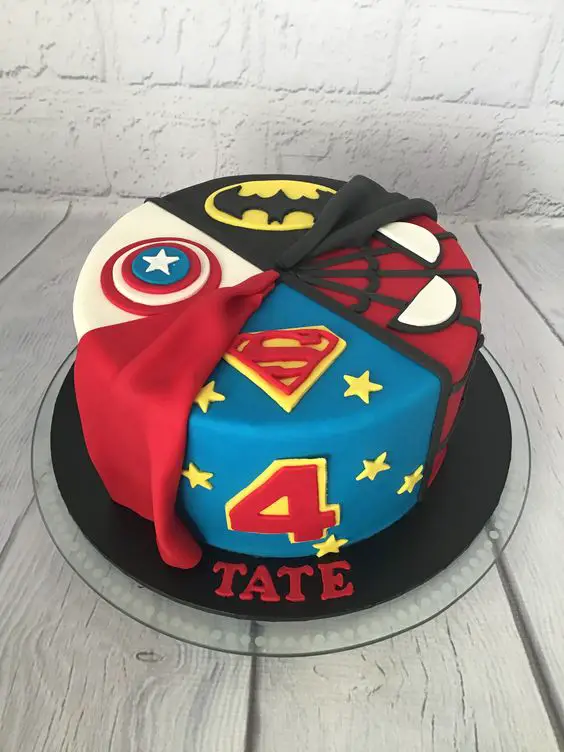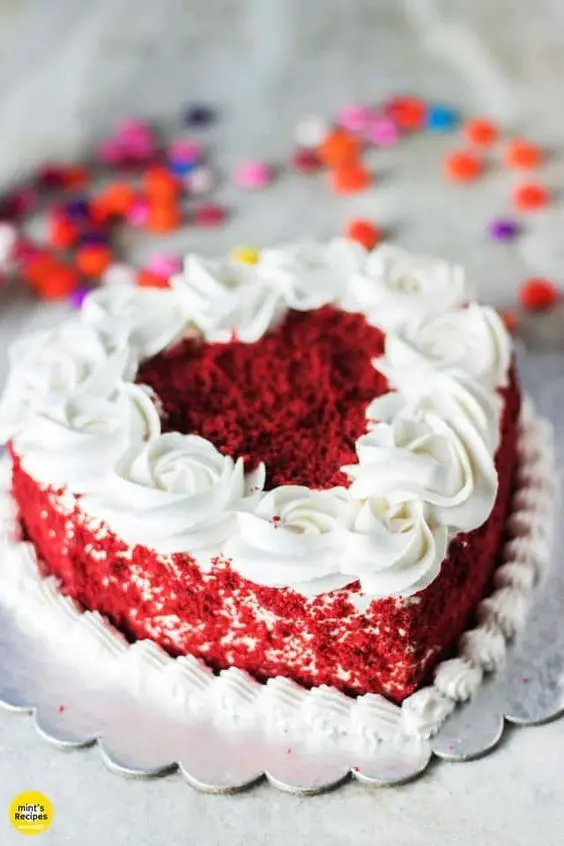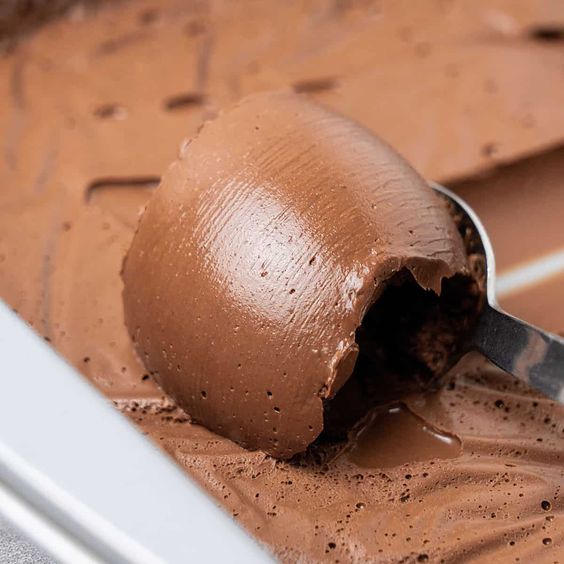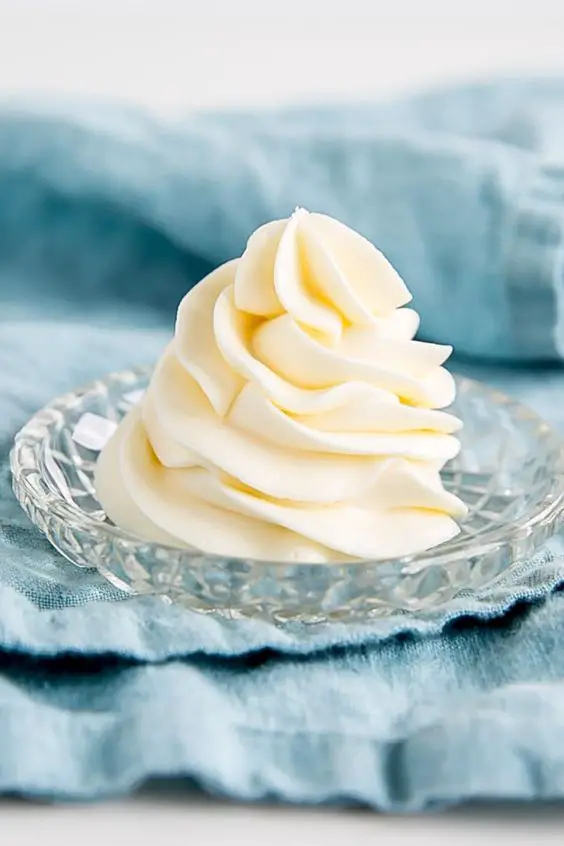Fondant cake is an exquisite and artistic masterpiece that has taken the world of baking and cake decorating by storm. This type of cake is characterized by its flawlessly smooth, sugar-based outer layer, known as fondant, which creates a canvas for boundless creativity and stunning designs.
Fondant, made from sugar, water, and glycerin, is rolled out into a thin, pliable sheet that covers the entire cake, creating a seamless and elegant finish. The smooth surface allows for intricate decorations, such as delicate flowers, elaborate patterns, and even lifelike figurines, making fondant cakes a true work of edible art.
Beyond its breathtaking appearance, fondant cake offers a delightful balance of flavors. Beneath the fondant layer, the cake can be filled with a variety of luscious fillings, such as buttercream, ganache, or fruit preserves, enhancing both taste and texture.
These cakes have become a popular choice for special occasions, including weddings, birthdays, anniversaries, and other celebrations, as they bring an element of elegance and sophistication to any event.
Fondant cakes represent the culmination of skillful baking, artistry, and imagination, making them a cherished centerpiece and a memorable highlight of joyous moments. Whether adorned with intricate details or simply showcasing a smooth, elegant finish, fondant cakes are sure to delight both the eyes and the taste buds of anyone fortunate enough to experience their enchanting charm.

What is fondant, and how is it different from buttercream?
Fondant:
Fondant is a type of smooth, pliable icing used to cover cakes and create decorative elements. It is made from a mixture of sugar, water, and glycerin, which is cooked and then kneaded to achieve a dough-like consistency. Fondant is rolled out into a thin sheet and then draped over the cake to provide a seamless and polished finish. It serves as a blank canvas for intricate cake decorations and designs. Fondant can be tinted with food coloring to achieve various colors and is known for its versatility in creating elaborate cake designs, including 3D figures, flowers, and intricate patterns. Fondant has a sweet taste and a slightly chewy texture, and some people choose to remove it before consuming the cake, while others enjoy its unique flavor.
Buttercream:
Buttercream is a creamy frosting made from a combination of butter, powdered sugar, and flavorings such as vanilla or chocolate. The ratio of butter to sugar determines the consistency of the buttercream, which can range from light and fluffy to rich and dense. Unlike fondant, buttercream is spread or piped onto the cake’s surface, creating a smooth or textured finish, depending on the decorator’s technique. Buttercream has a luxurious, buttery taste and a creamy, soft texture that complements the cake’s crumb. It is well-loved for its delectable flavor and can be easily flavored with various extracts, cocoa powder, or fruit purees to match different cake flavors. Buttercream is often used for both filling and frosting cakes and is a popular choice for classic, rustic, or more casual cake designs.
Differences: The main differences between fondant and buttercream are in their ingredients, texture, and application methods:
- Ingredients: Fondant is primarily made from sugar, water, and glycerin, while buttercream consists of butter, powdered sugar, and flavorings.
- Texture: Fondant has a smooth and slightly chewy texture, akin to a pliable dough. On the other hand, buttercream is creamy and soft, with a rich and luxurious mouthfeel.
- Application: Fondant is rolled out and draped over the cake to create a seamless covering, while buttercream is spread or piped onto the cake’s surface. Fondant provides a polished, flawless finish, while buttercream can have a more rustic or textured appearance.
- Taste: Fondant has a sweet taste, and some people choose to remove it before eating the cake. In contrast, buttercream is celebrated for its delicious, buttery flavor, which complements the cake’s taste.
Both fondant and buttercream have their unique merits, and decorators often choose between them based on the desired cake design, flavor preferences, and the occasion. Fondant is favored for its intricate decorative possibilities, while buttercream is beloved for its delicious taste and versatility.

Why you will love Fondant Cake?
However, I can certainly highlight why many people love fondant cakes based on their unique characteristics and appeal:
1. Stunning Visual Appeal: Fondant cakes are renowned for their flawless, smooth, and polished finish. The immaculate surface of fondant creates a beautiful canvas for intricate and artistic cake decorations. From delicate flowers to elaborate patterns, fondant cakes are a feast for the eyes and are often the centerpiece of celebrations and special occasions.
2. Endless Creative Possibilities: Fondant is incredibly versatile and can be molded and shaped into a wide array of designs, making it a dream medium for cake decorators and artists. With fondant, the possibilities are almost limitless, allowing for the creation of custom cake designs that suit any theme or event.
3. Customizable Colors: Fondant can be tinted with food coloring, enabling decorators to match the cake’s color scheme with the event’s theme or personal preferences. This feature allows for beautifully coordinated cakes that seamlessly blend with the overall decor.
4. Professional and Elegant Look: Fondant cakes exude an air of sophistication and elegance, making them perfect for formal events such as weddings, anniversaries, and corporate gatherings. The smooth finish and intricate details lend a professional touch to the cake, impressing both hosts and guests alike.
5. Versatile Flavors: Underneath the fondant layer, a fondant cake can be filled with a variety of delicious flavors, such as rich chocolate, velvety red velvet, or fruity layers. This variety ensures that there’s a fondant cake to suit every palate.
6. Ideal for Special Occasions: Fondant cakes are often associated with celebratory events and milestones. They are a popular choice for weddings, birthdays, baby showers, graduations, and other significant moments in life, making them a symbol of joy and festivity.
7. Wow Factor: Fondant cakes have a “wow” factor that leaves a lasting impression on guests. The intricate designs and attention to detail make these cakes stand out and become memorable centerpieces at any gathering.
8. Fun and Playful Designs: Fondant allows for the creation of fun and whimsical cake designs, making it perfect for children’s birthday parties or themed events. From cartoon characters to favorite animals, fondant can transform a cake into a delightful edible work of art.
9. Impressive Edible Art: Fondant cakes are more than just desserts; they are edible works of art. The craftsmanship and creativity that go into creating a fondant cake make it an extraordinary and cherished treat.
10. Satisfying for Cake Enthusiasts: For cake enthusiasts, fondant cakes offer a unique and rewarding challenge. Whether professionally decorating or trying it as a hobby, working with fondant allows cake decorators to express their creativity and improve their skills.
Overall, fondant cakes are adored for their impeccable aesthetics, limitless creativity, and the joy they bring to any celebration. They combine delectable flavors with artistic designs, making them a captivating and unforgettable addition to any special occasion.

Creating a fondant cake involves two main components: the cake itself and the fondant used to cover and decorate it. Below are the details of ingredients and quantities for both aspects of a fondant cake:
Vanilla Cake Recipe:
Ingredients:
- 2 cups all-purpose flour
- 2 teaspoons baking powder
- 1/2 teaspoon salt
- 1 cup (2 sticks) unsalted butter, softened
- 1 1/2 cups granulated sugar
- 4 large eggs, at room temperature
- 1 teaspoon pure vanilla extract
- 1 cup whole milk, at room temperature
Instructions:
- Preheat the oven to 350°F (175°C). Grease and flour two 8-inch round cake pans or line them with parchment paper.
- In a medium bowl, whisk together the flour, baking powder, and salt. Set aside.
- In a large mixing bowl, beat the softened butter and granulated sugar together until light and fluffy.
- Add the eggs, one at a time, beating well after each addition. Mix in the vanilla extract.
- Gradually add the dry ingredients to the wet ingredients, alternating with the milk, starting and ending with the dry ingredients. Mix until just combined, being careful not to overmix.
- Divide the batter evenly between the prepared cake pans.
- Bake in the preheated oven for about 25-30 minutes or until a toothpick inserted into the center comes out clean.
- Allow the cakes to cool in the pans for 10 minutes before transferring them to a wire rack to cool completely.
Fondant Cake Recipe:
Ingredients:
- 1 (2 lb) package of commercially prepared fondant or homemade fondant
- Food coloring (gel or liquid) as needed to tint the fondant to the desired colors
Instructions:
- If using store-bought fondant, follow the instructions on the package for kneading and rolling it out to cover the cake.
- If making homemade fondant, you will need the following ingredients:
- 1 (16-ounce) package of miniature marshmallows
- 2 tablespoons water
- 2 pounds powdered sugar (confectioners’ sugar)
- Food coloring (gel or liquid) as needed for tinting
- Vegetable shortening for greasing the hands and work surface
- Cornstarch for dusting the work surface
- For homemade fondant instructions, here’s a basic outline:
- In a microwave-safe bowl, melt the marshmallows with water in 30-second intervals until smooth.
- Gradually add powdered sugar to the melted marshmallows, mixing with a greased spoon until it becomes a dough.
- Transfer the fondant to a greased work surface and knead it until smooth and pliable. Add food coloring during kneading to achieve the desired colors.
- Wrap the fondant in plastic wrap and let it rest for at least 30 minutes before using.
Assembling the Fondant Cake:
- Once the cakes are completely cooled, level the tops if needed to create an even surface.
- Roll out the fondant on a clean, lightly greased and dusted work surface to a thickness of about 1/8 to 1/4 inch, large enough to cover the entire cake.
- Carefully lift the rolled fondant and drape it over the cake, smoothing it gently over the top and sides to avoid air bubbles or wrinkles.
- Trim any excess fondant from the bottom of the cake using a sharp knife or pizza cutter.
- Decorate the fondant cake as desired with additional fondant decorations, edible paint, or other edible elements.
Please note that the quantity of fondant required may vary depending on the size of the cake and the amount of decoration desired. It’s a good idea to have extra fondant on hand for decorations and any unforeseen needs.
Also, consider that the above recipe assumes you are using a basic vanilla cake and commercially prepared fondant or homemade fondant. Fondant cakes can be customized with various cake flavors, fillings, and creative decorations based on your preferences and skills as a cake decorator.

FAQs and Troubleshooting about Fondant Cake:
1. What is fondant, and how is it different from buttercream? Fondant is a smooth, sugar-based icing that covers the entire cake and provides a clean and flawless surface for decorations. It is made from sugar, water, and glycerin and has a pliable, dough-like texture. Buttercream, on the other hand, is a creamy frosting made from butter, powdered sugar, and flavorings. While fondant creates a polished finish, buttercream offers a softer texture and a rich, buttery taste.
2. Can I eat the fondant on the cake? Yes, fondant is entirely edible, and many people enjoy the unique taste and texture it adds to the cake. However, some individuals might choose to remove the fondant before eating the cake, as it can be quite sweet.
3. How should I store a fondant cake? Fondant cakes should be stored at room temperature in a cool, dry place, away from direct sunlight and humidity. Avoid refrigerating fondant cakes as condensation can cause the decorations to become soft and lose their shape.
4. How long will a fondant cake last? Fondant cakes can typically stay fresh for up to 2-3 days at room temperature. If you need to store the cake for a more extended period, it’s best to freeze it (without any delicate decorations) and thaw it at room temperature when ready to serve.
5. Can I refrigerate a fondant cake with perishable fillings? If the fondant cake has perishable fillings, such as whipped cream or fresh fruit, it’s advisable to refrigerate it. However, keep in mind that refrigeration might cause the fondant to develop condensation when removed, affecting the appearance of the cake. To minimize this, place the cake in an airtight container before refrigeration.
6. How can I prevent air bubbles or wrinkles in the fondant when covering the cake? To avoid air bubbles or wrinkles, ensure that the cake is smoothly and evenly coated with a thin layer of buttercream or ganache before applying the fondant. Roll the fondant carefully and lift it gently over the cake, smoothing it with your hands from the center outwards to eliminate any air trapped underneath.
7. Can I fix tears or imperfections in the fondant? If the fondant develops small tears or imperfections, you can use a small amount of water to smooth and blend the edges back together. Be cautious not to use too much water, as it can dissolve the fondant.
8. How far in advance can I decorate a fondant cake? Fondant decorations can be made in advance and stored in an airtight container at room temperature. However, it’s best to apply the fondant to the cake no more than a day or two before serving to maintain its freshness and appearance.
9. Can I freeze a fondant cake? While freezing a fondant-covered cake is possible, it is not ideal as condensation can affect the appearance of the decorations when thawed. If necessary, you can freeze the cake (without delicate decorations) in an airtight container, then thaw it at room temperature before applying the fondant.
10. Can I color or paint on fondant decorations? Yes, fondant is an excellent canvas for coloring and painting. You can use food coloring gels or edible paint to create custom designs and vibrant decorations on the fondant.
Remember, working with fondant requires practice and patience, so don’t be discouraged by any challenges you encounter. With time and experience, you’ll master the art of creating stunning fondant cakes that delight both the eyes and the taste buds.

How to serve Fondant Cake
Serving a fondant cake requires some care and attention to ensure that its appearance remains intact and that everyone can enjoy its delicious taste. Here’s how to serve a fondant cake:
- Prepare in Advance: If the fondant cake has been refrigerated, take it out of the fridge at least an hour before serving to allow it to come to room temperature. This helps soften the fondant slightly and enhances the cake’s flavor.
- Clean Knife: Make sure the knife you use to cut the cake is clean and free from any icing or crumbs. A sharp, non-serrated knife or a cake server works best to make clean and smooth cuts through the fondant.
- Remove Any Decorations: Before slicing the cake, remove any fondant decorations that might be on top or along the sides. Set these decorations aside to be served along with the cake slices.
- Cutting the Cake: To cut the fondant cake, insert the knife or cake server straight down into the cake and lift each slice carefully. Avoid using a sawing motion, as this can damage the fondant and create a messy appearance.
- Serve with Decorations: Place each slice on individual plates and add any fondant decorations you removed earlier as a lovely finishing touch to each serving.
- Enjoy: Serve the fondant cake to your guests and watch as they delight in the visual appeal and savor the delectable combination of the cake’s flavor and the fondant’s sweet taste.
- Leftovers: If there are any leftover slices, store them in an airtight container at room temperature. However, keep in mind that fondant cakes are best enjoyed fresh, and the fondant might lose some of its smoothness and texture over time.
- Caution with Weather: Be mindful of weather conditions, especially in warm and humid environments. Fondant is susceptible to moisture, which can cause it to soften and lose its shape. If the weather is hot or humid, consider serving the cake indoors with air conditioning to maintain its appearance.
By following these steps, you can serve a fondant cake with care and ensure that both its stunning appearance and delicious taste are enjoyed to the fullest by everyone.

How to store Fondant Cake
Storing a fondant cake properly is essential to maintain its appearance, texture, and taste. Here are the steps to store a fondant cake:
- Room Temperature Storage: Fondant cakes are best stored at room temperature in a cool, dry place away from direct sunlight. If the cake has perishable fillings or frosting, it should not be left at room temperature for more than 2-3 days to ensure food safety.
- Avoid Refrigeration (in Most Cases): Generally, it is not recommended to refrigerate fondant-covered cakes. Refrigeration can cause condensation to form on the fondant, leading to a loss of smoothness and potentially causing colors to bleed or decorations to become soggy. However, if the cake has perishable fillings, such as whipped cream or fresh fruit, refrigeration might be necessary. In such cases, follow the guidelines below for refrigeration.
- Refrigerating with Perishable Fillings: If the cake contains fillings or frosting that require refrigeration, place the cake in an airtight container or cake box. Before refrigerating, cover the cake box with plastic wrap to create a seal and prevent moisture from reaching the fondant. This will help minimize the risk of the fondant absorbing moisture and becoming sticky.
- Thawing Frozen Fondant Cakes: If you have a fondant cake that was frozen for later use, allow it to thaw at room temperature inside the airtight container or cake box. This will help prevent condensation from forming on the fondant as it comes back to room temperature.
- Avoid Freezing Decorated Cakes: Freezing decorated fondant cakes is generally not recommended. Freezing and thawing can cause the fondant to become sticky and lose its smooth texture. If you must freeze a fondant cake, it is advisable to freeze the cake before applying the fondant, and then add the fondant after thawing.
- Avoid Touching the Fondant: When storing or serving the fondant cake, try to avoid touching the fondant surface with your fingers, as this can leave marks or smudges.
- Serve Fresh for Best Results: Fondant cakes are best enjoyed fresh. Aim to serve the cake on the same day or within 2-3 days after decorating for the best taste and appearance.
Remember that extreme temperatures, both hot and cold, can affect the quality of the fondant and the cake underneath. Always consider the specific ingredients and fillings used in your cake, as well as the weather conditions, when deciding how to store your fondant creation. Proper storage will help ensure that your fondant cake looks stunning and tastes delicious when served to your guests.
Happy baking!

